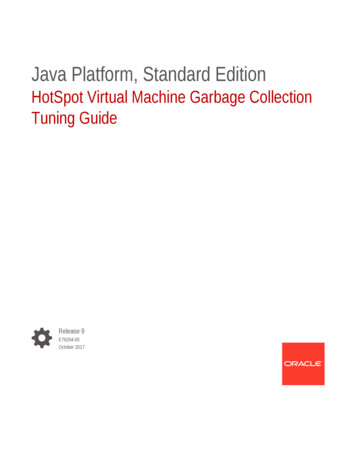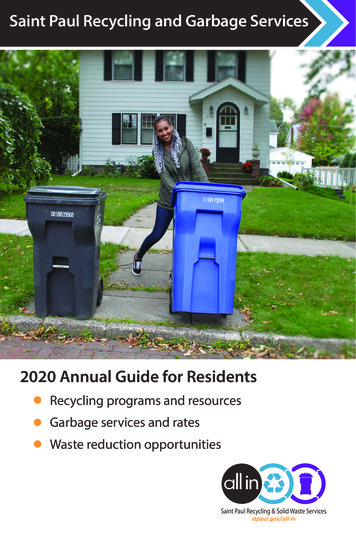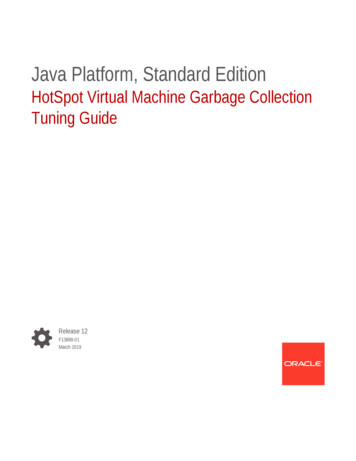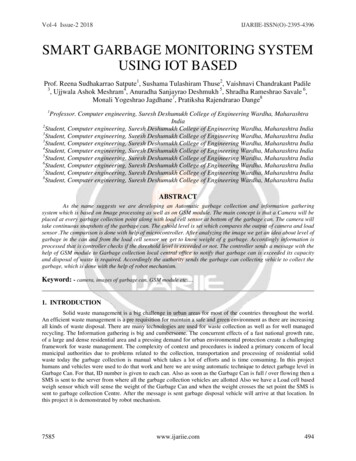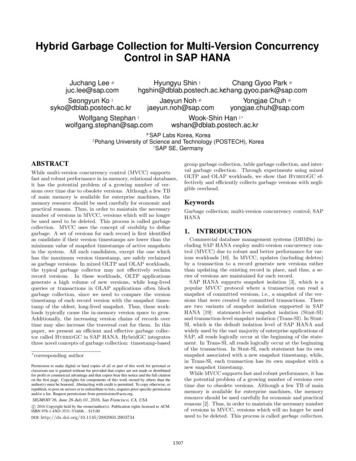
Transcription
Hybrid Garbage Collection for Multi-Version ConcurrencyControl in SAP HANAJuchang Lee #Hyungyu Shin ‡Chang Gyoo Park oo.park@sap.comSeongyun Ko ‡Jaeyun Noh #Yongjae Chuh .chuh@sap.com†Wolfgang StephanWook-Shin Han ‡ ‡SAP Labs Korea, KoreaPohang University of Science and Technology (POSTECH), Korea†SAP SE, GermanyABSTRACTWhile multi-version concurrency control (MVCC) supportsfast and robust performance in in-memory, relational databases,it has the potential problem of a growing number of versions over time due to obsolete versions. Although a few TBof main memory is available for enterprise machines, thememory resource should be used carefully for economic andpractical reasons. Thus, in order to maintain the necessarynumber of versions in MVCC, versions which will no longerbe used need to be deleted. This process is called garbagecollection. MVCC uses the concept of visibility to definegarbage. A set of versions for each record is first identifiedas candidate if their version timestamps are lower than theminimum value of snapshot timestamps of active snapshotsin the system. All such candidates, except the one whichhas the maximum version timestamp, are safely reclaimedas garbage versions. In mixed OLTP and OLAP workloads,the typical garbage collector may not effectively reclaimrecord versions. In these workloads, OLTP applicationsgenerate a high volume of new versions, while long-livedqueries or transactions in OLAP applications often blockgarbage collection, since we need to compare the versiontimestamp of each record version with the snapshot timestamp of the oldest, long-lived snapshot. Thus, these workloads typically cause the in-memory version space to grow.Additionally, the increasing version chains of records overtime may also increase the traversal cost for them. In thispaper, we present an efficient and effective garbage collector called HybridGC in SAP HANA. HybridGC integratesthree novel concepts of garbage collection: timestamp-based corresponding authorPermission to make digital or hard copies of all or part of this work for personal orclassroom use is granted without fee provided that copies are not made or distributedfor profit or commercial advantage and that copies bear this notice and the full citationon the first page. Copyrights for components of this work owned by others than theauthor(s) must be honored. Abstracting with credit is permitted. To copy otherwise, orrepublish, to post on servers or to redistribute to lists, requires prior specific permissionand/or a fee. Request permissions from permissions@acm.org.SIGMOD’16, June 26-July 01, 2016, San Francisco, CA, USAc 2016 Copyright held by the owner/author(s). Publication rights licensed to ACM.ISBN 978-1-4503-3531-7/16/06. . . 15.00DOI: http://dx.doi.org/10.1145/2882903.29037341307group garbage collection, table garbage collection, and interval garbage collection. Through experiments using mixedOLTP and OLAP workloads, we show that HybridGC effectively and efficiently collects garbage versions with negligible overhead.KeywordsGarbage collection; multi-version concurrency control; SAPHANA1.INTRODUCTIONCommercial database management systems (DBMSs) including SAP HANA employ multi-version concurrency control (MVCC) due to robust and better performance for various workloads [10]. In MVCC, updates (including deletes)by a transaction to a record generate new versions ratherthan updating the existing record in place, and thus, a series of versions are maintained for each record.SAP HANA supports snapshot isolation [3], which is apopular MVCC protocol where a transaction can read asnapshot of committed versions, i.e., a snapshot of the versions that were created by committed transactions. Thereare two variants of snapshot isolation supported in SAPHANA [19]: statement-level snapshot isolation (Stmt-SI)and transaction-level snapshot isolation (Trans-SI). In StmtSI, which is the default isolation level of SAP HANA andwidely used by the vast majority of enterprise applications ofSAP, all reads logically occur at the beginning of the statement. In Trans-SI, all reads logically occur at the beginningof the transaction. In Stmt-SI, each statement has its ownsnapshot associated with a new snapshot timestamp, while,in Trans-SI, each transaction has its own snapshot with anew snapshot timestamp.While MVCC supports fast and robust performance, it hasthe potential problem of a growing number of versions overtime due to obsolete versions. Although a few TB of mainmemory is available for enterprise machines, the memoryresource should be used carefully for economic and practicalreasons [2]. Thus, in order to maintain the necessary numberof versions in MVCC, versions which will no longer be usedneed to be deleted. This process is called garbage collection.
MVCC uses the concept of visibility to define garbage.Specifically, in typical commercial DBMSs supporting MVCC,a set of versions for each record is first identified as a candidate if their version timestamps are lower than the minimum value (a.k.a. the global minimum timestamp) of snapshot timestamps of active snapshots in the system. All suchcandidates, except the one which has the maximum versiontimestamp, are safely reclaimed as garbage versions. Onecan guarantee that such record versions will no longer bevisible to any active snapshots. Figure 1 shows how thetypical garbage collector identifies garbage versions. First,the global minimum timestamp is set to 3. Thus, the conventional garbage collector identifies v11 only as garbage,since its version timestamp ( 1) is lower than 3, and thereexists v12 whose version timestamp 2 is also lower than 3.However, notice that both v13 and v14 are invisible to anyactive transaction, and thus, they should be subject to being“garbage collected.”Figure 1: An example of record versions.In mixed OLTP and OLAP workloads, the typical garbagecollector may not effectively reclaim record versions. Inthese workloads, OLTP applications generate a high volumeof new versions, while long-lived queries (under Stmt-SI) ortransactions (under Trans-SI) in OLAP applications oftenblock garbage collection, since we need to compare the version timestamp of each record version with the snapshottimestamp of the oldest, long-lived snapshot. Thus, theseworkloads typically cause the in-memory version space togrow. Additionally, the increasing version chains of recordsover time may also increase the traversal cost for them. Wealso observe other types of garbage collection blockers inreal customer systems. Long-duration cursors or Trans-SItransactions due to either application logic or developers’mistakes can easily block garbage collection. For example,we collected statistics on cursor durations from a real ERPsystem. Out of 408,664 distinct queries executed in the system, the life times of six cursors were more than one hour!Figure 2 shows the impact of the long-lived snapshot whenthere exists no optimized garbage collector. This real screenshot is taken from the HANA system load view, which visualizes the status of key performance indicators in the systemover time. Especially, the light blue color, marked as ”Active Commit ID Range”, denote the difference between thelast CID value and the minimum global snapshot timestampvalue. If the value increases, this means that there is at leastone long-live snapshot in the system. The number of recordversions, marked as ”Active Versions” in blue color, keepsincreasing over time. As a result, the system’s memory consumption, marked as ”Used Memory” with green color, keepsgrowing.Conventional workarounds for this version space overflow1308Figure 2: A real example of version space overflowproblem.problem are as follows. 1) The system flushes old versionsout to disk. 2) The system closes problematic cursors orTrans-SI transactions by force and returns errors to clients.This is implemented in SAP HANA, especially to handleapplication developers’ mistakes. 3) The system implicitlycloses cursors earlier than the explicit cursor close request; assoon as the query results are materialized or the system canguarantee that there is no more request to access the versionspace, the system implicitly closes cursors. This workaroundis also supported in SAP HANA for a limited set of cases.In order to collect more garbage versions, unlike the traditional garbage collector which uses the global minimumtimestamp, we propose an interval garbage collector thatuses visible intervals among consecutive timestamps of eachrecord version. Here, the visible interval [s, e) for a recordv represents a set of snapshot timestamps to which v canbe visible. The traditional garbage collector uses the globalminimum timestamp and is thus unable to collect record versions which are invisible to any active or future snapshots.For example, v13 , and v14 are invisible to any active transactions. Visible intervals for the record 1 of Figure 1 are {[1,2), [2, 4), [4, 5), [5, 99), [99, )}. Consider the interval forv13 , [4, 5). No active snapshot timestamp is included in thisinterval. Thus, v13 is invisible to any active snapshot andcan be reclaimed as garbage. Similarly, v14 whose visibleinterval is [5, 99) is also reclaimed as garbage if we use thisinterval-based decision.Garbage collection may incur non-negligible overhead fornormal transaction processing. In order to efficiently collectgarbage, we propose the concept of the group garbage versioncollector. Typically, a set of versions generated by the sametransaction can form a group, and thus, the garbage collectorchecks whether this group can be reclaimed as a whole. Thegroup garbage collector can also be implemented using eitherthe timestamp-based decision or the interval-based decision.Figure 3 shows the taxonomy of 4-quadrants of garbagecollectors containing two dimensions. Along the dimensionof garbage granularity, a garbage version can be either a single record version or a group version. Along the dimension ofcomparison unit, there exist timestamp-based and intervalgarbage collectors. Thus, we can have four types of garbagecollectors (ST, SI, GT, and GI). Note that existing garbagecollectors belong to ST.In addition to granularity and comparison unit, we can exploit semantic optimization for efficiently collecting garbageversions. Under Stmt-SI or some special cases of Trans-SI(e.g. pre-compiled stored procedures), one can reclaim moregarbage versions by identifying the tables which are not relevant to the currently long-running snapshots. In this paper,
2.PRELIMINARIESIn this section, we first explain the architecture of SAPHANA. We then explain how SAP HANA manages the version space.2.1SAP HANA In-memory DatabaseSAP HANA is an ACID-compliant and in-memory relational DBMS, designed to efficiently handle both of OLTPand OLAP workloads together in a single system [16,18,19].SAP HANA has both an in-memory column store and anin-memory row store for high-performance OLAP and highperformance OLTP, respectively.In order to seamlessly integrate the column store and rowstore from transaction and query processing perspectives,the unified transaction manager and the unified query processor are built on top of the two different stores. For example, the unified transaction manager provides durabilitybased on logging and checkpointing to a common persistency, and it also provides snapshot isolation based on thecommon commit timestamp.For supporting snapshot isolation, the transactions acrossthe row store and the column store are centrally controlledby the unified transaction manager although each store hasits own version space layout. While the garbage collectionscheme proposed in this paper can also be applied to thecolumn store, the rest of this paper is described based onits implementation at the row store for convenience of thedescription.Figure 3: The taxonomy of garbage collectors.this type of garbage collector is called the table garbage collector (TG).In order to execute effective and efficient garbage collection, we propose the novel concept of hybrid garbage collector which executes GT, TG, and SI in this order. GTis a light-weight garbage collector since it examines groupgarbage versions only. TG is also effective under Stmt-SIand relatively lighter than SI. Although the SI can reclaimmore garbage versions, it can be heavier than the others.Thus, we propose an efficient algorithm for SI to identifygarbage versions using visible intervals.In summary, this paper makes the following key contributions. We propose the novel concept of interval garbage collection. For this, we formally model the garbage collection problem as the consecutive interval intersectionproblem. Then, we provide an efficient merge-basedsolution to this problem.2.2Version Management in HANA RowStoreThe in-memory area in the SAP HANA row store consists of the table space and the version space. Since the rowstore implements the snapshot isolation based on MVCC,the newly added version is appended to the version space,instead of performing the in-place update directly to the table space. Later on, by garbage collection, the added data ismoved to the table space once it is certain that there is nopotential reader to the original data maintained in the table space. In this way, the table space maintains the oldestversions of the existing records while the version space maintains newer record versions until they are reclaimed or theirrecord images are copied to the table space by a garbagecollector.In particular, on every INSERT/UPDATE/DELETE operation, a record version (or a version entry—we use theterms interchangeably) is created at the version space. Asingle record version consists of a version header and itspayload. The version header stores the creator’s operationtype, the changed record’s identifier (RID), the table IDwhich the record belongs to, and a few pointers to maintainversion chains. The payload stores the new record image forthe UPDATE operation. For the INSERT operation, thenew record image is directly inserted into the table spacesince there is no older image for the particular record.In the version space, the record versions having the sameRID are linked with each other in the latest-first order. Differently from organizing the version entries in the oldest-firstorder, the latest-first ordering in the version chain can reduce the cost of traversing version chains for future queriesand transactions. This is more likely to access more recentversions by the nature of snapshot isolation. The pointerto the latest record version of each version chain is maintained by a central hash table, called RID hash table, for We propose the novel concept of group garbage collection. This granular garbage collection enables us to efficiently determine a set of record versions as garbage.Furthermore, this concept can be applied to typical,minimum snapshot timestamp-based garbage collection as well as interval garbage collection. We propose the novel concept of table garbage collection. This exploits the semantic information that versions in tables which are irrelevant to current snapshots can be reclaimed at any time. We present a hybrid garbage collector which combinesthree different flavors of garbage collectors. Thus, wecan effectively and efficiently collect garbage versionswith negligible performance overhead. We implement the hybrid garbage collector in SAPHANA and perform extensive experiments using a modified TPC-C benchmark which includes long-runningqueries. Experimental results confirm that the hybridgarbage collector effectively collects garbage versionsand considerably reduces the latency of long-runningOLAP queries.The rest of this paper is organized as follows. Section 2reviews some background information in SAP HANA. InSection 3, we propose the concept of the interval garbage collector. Section 4 presents the concepts of the group garbageversion, table garbage collection, and the hybrid garbage collection for SAP HANA. In Section 5, we present the resultsof performance evaluations, and Section 6 reviews relatedwork. Section 7 concludes the paper.1309
Figure 4: Version management in the HANA row store.fast RID-to-version-chain lookup. In order to reduce thecost of checking whether a particular record has its own version chain, each record in the table space stores the so-calledis versioned flag. This flag is set only when the record inthe table space has additional record versions in the versionspace. If this flag is not set, looking up the hash table canbe skipped.The RID hash table is implemented as a chained hashstructure. Basically, it is an array of hash buckets, each ofwhich stores the pointer to the corresponding version chain.However, if multiple version chains are associated to a singlehash bucket, the hash bucket creates additional linked listto maintain the pointers to the multiple version chains. Asthe result, if a single hash bucket contains 10 version chains,then the query accessing the hash bucket may encounter 5additional pointer traversals in average and 10 additionalpointer traversals in the worst case just to find the corresponding version chain. Since every pointer traversal in thisadditional chain may lead to hardware-level cache misses,this cost can significantly affect the overall performance, especially for short-running queries and transactions wherethe version space access cost takes a non-trivial portion ofits execution time. Remark that the row store is currentlyimplemented using the RID hash table, considering that anefficient garbage collector can reduce the probability of thehash collisions. The detailed experimental analysis on theperformance impact of such hash collisions is given in Section 5.The record versions created by the same transaction areassociated as a group by pointing to the same data object,called TransContext. When a transaction issues a write operation for the first time, it creates a TransContext object.All the next record versions created by the transaction pointto the same TransContext object. The TransContext objectpoints to NULL until the corresponding transaction starts tocommit. On transaction commit, once the set of write transactions to be committed together is decided by the groupcommit logic, another object called GroupCommitContextis created, and thus the TransContext objects for all concurrent transactions committing together point to the sameGroupCommitContext object. After that, if the commit ID(CID) is decided for the group commit operation, the CIDis written to the GroupCommitContext object, and the CIDbecomes immediately visible to all related TransContext objects and version entries which share the same CID value.This atomic, indirect CID assignment scheme is more efficient than the approach of directly copying the CID valuesto the record versions. The indirect CID assignment is donein an atomic way without relying on any latch or lock, andthus is efficient.The expected penalty in the atomic indirect CID assignment is that the accessing the CID value of a record version may have to follow an additional pointer, but this costcan be minimized by asynchronously propagating the CIDvalue from the GroupCommitContext object to the individual record versions. For efficient backward CID propagation,backward links from the GroupCommitContext object to individual record version are also maintained.Figure 4 illustrates the version space management schemein the row store. We assume the records R1 , R2 , and R3are already in a user table. The transaction T1 generatesthe record versions V21 and V31 and commits with creatingTransContext T1 . The transaction T2 generates the recordversions V12 and commits with creating TransContext T2 .Since T1 and T2 are committed together by the same groupcommit operation, they share the same GroupCommitContext C1 . Then, the transaction T3 generates the record version V13 and V33 and commits with creating TransContextT3 and GroupCommitContext C2 .3.VARIANTS OF GARBAGE COLLECTORIn the paper, we classify garbage collectors into four variants according to the comparison unit and the granularity.3.1Timestamp vs Interval Garbage CollectorConventional, timestamp-based garbage collectors identify a version record by comparing its timestamp with active snapshot timestamps. Specifically, a set of versions foreach record is first identified as a candidate if their versiontimestamps are lower than the global minimum timestampin the system. All such candidates, except the one whichhas the maximum version timestamp, are safely reclaimedas garbage versions. Such record versions will no longer bevisible to any active snapshots.Before we explain interval garbage collectors, we formallymodel the interval-based garbage collection as the consecutive interval intersection problem. First, we define someterminology and introduce the consecutive intersection problem. We then propose an efficient merge-based solution tothis problem.1310
Consider an integer t and an ordered sequence S of integers. Without loss of generality, we assume that S alwayscontains a number which is larger than or equal to any t.Then, the least greater number (LGN) for t with respect toS is defined as the smallest number in S such that the number is greater than or equal to t. We denote the least greaternumber by LGN(t,S). Suppose that t 10, and S [1, 4, 6,8, 12, 14]. Then, LGN(t,S) min{12, 14} 12. If t 15,LGN(t,S) .can efficiently check whether a (version) group is reclaimedas garbage. That is, we can directly apply the timestampbased garbage collector to both the single version and theversion group. Such garbage collectors are classified as STand GT, respectively.Now, we explain how we can apply the interval garbagecollector to the version group. For this purpose, we proposethe novel concept of immediate successor subgroup.The immediate successor subgroup in a group Gi consistsof record versions in Gi which have the immediate successors in the next group Gi 1 . Then, we can apply the interval garbage collector to an ordered sequence of immediatesuccessor subgroups. In this scheme, we need an efficient,systematic mechanism to move a record version in Gi toform its immediate successor subgroup, which is beyond ofthe scope of our paper and would be an interesting futuretopic of research.Figure 5 shows an ordered sequence of k groups. Eachgroup Gi has one immediate successor subgroup denotedby sgi . Note that the version v1 belongs to sg1 since itsimmediate successor is in G2 , while the version v2 does not.However, if we generate the immediate successor of v2 andinsert the successor into G2 , then v2 belongs to sg1 . Notethat sgk does not contain any record version since Gk is thelast group in the ordered sequence.Definition 1 (Consecutive interval intersection).Given two ordered sequences of integers, S and T , find thesubset T of T satisfying the following condition.T {t t T, LGN(t 1, T ) LGN(t, S)}(1)Consider S [90, 92, 95, 96, 99] and T [91, 93, 94, 95,98]. We can compute LGN(t 1, T ) and LGN(t,S) for eacht. Finally, we can compute T {93, 94}.Suppose that S is an ordered sequence of snapshot timestamps, and T is an ordered sequence of record versions for arecord. Then, the elements in T are identified as garbage.Here, [t, LGN(t 1, T )) is called visible interval for t.Now, we explain how to compute T . The naive wayto compute T uses nested loops. That is, for each recordversion t, we perform a set intersection operation for everysnapshot timestamp in S. Then, the time complexity isO( T S ).In order to minimize the garbage collection overhead, wenow propose a merge-based solution. Algorithm 1 shows amerge-based garbage collector. It computes T in Eq. (1)in O( T S ). We denote the i-th element of T by T [i].In order to merge two ordered sequences, we maintain twoindex variables, i and j. For each element T [i], we movej until S[j] T [i] (Lines 3 4). Then, S[j] should beLGN(T [i], S). If S[j] T [i 1], then T [i] is identified asgarbage. Otherwise, we skip T [i] by incrementing i since itis not garbage.Figure 5: An ordered sequence of k groups containing immediate successor subgroup.Algorithm 1 MergeBasedGC(S, T )Input: Two ordered sequence of integers S, T .Output: T .1: i 0, j 02: while i T -1 do3:if S[j] T [i] then4:j j 15:else if T [i 1] S[j] then/ T [i 1] represents LGN(T [i] 1, T ). /6:T T T [i]7:i i 18:else9:i i 110:end if11: end while12: return T Now, we can apply the interval garbage collector to boththe single version and the version group. Such garbage collectors are classified as SI and GI, respectively. In the nextsection, we explain how these garbage collectors are implemented in SAP HANA.4.This section describes how the proposed interval garbagecollector and the group garbage collector are implementedin SAP HANA together with the additional practical optimizations. Specifically, we describe GT, SI, and the tablegarbage collectors implemented in SAP HANA.4.13.2IMPLEMENTATION IN SAP HANAGlobal Group Garbage CollectorGT is implemented as the global garbage collector in SAPHANA, considering the following two optimization strategies: (1) efficiently select the minimum global snapshot timestamp value and (2) efficiently detect a group of garbage versions.As the first optimization strategy, the so-called global snapshot timestamp tracker (global STS tracker) is maintainedSingle vs Group Garbage CollectorThe granularity for garbage collectors can be either a single record version or a group of record versions. All recordversions generated by transactions belonging to the sameGroupCommitContext have the same version timestamp.Thus, if we group record versions by their timestamp, we1311
globally in the system. The global STS tracker is an orderedlist of reference-counted snapshot timestamp values. Whena snapshot starts, it acquires its snapshot timestamp valuefrom the transaction manager according to the definitionof snapshot isolation. If the acquired snapshot timestampvalue is already in the tracker, we simply increment the reference count of the corresponding snapshot timestamp objectby one. Otherwise, a new snapshot timestamp object is inserted into the tracker. Then, if the snapshot associated witha query or a transaction finishes its processing, the referencecount of the corresponding snapshot timestamp decrementsby one. When the reference count becomes zero, the corresponding snapshot object is deleted from the global STStracker. Since each active snapshot maintains a pointer tothe corresponding snapshot timestamp object in the globalSTS tracker as shown in Figure 6, we can directly access thesnapshot timestamp object without scanning the entire listin the tracker. Note that the snapshot timestamp values inthe global STS tracker are maintained in increasing order.When the global garbage collector needs to find the globalminimum snapshot timestamp value at a certain time point,accessing the head of the list without scanning the entiretracker is sufficient.Figure 7: Global Group Garbage Collection.the following four steps. (1) The full set of active snapshot timestamps is retrieved by scanning the whole snapshot timestamp values maintained by the global STS tracker.Let’s denote the ordered set of active snapshot timestampvalues by S (following the same notation at Definition 1).(2) At the second step, the interval garbage collector scansthe existing GroupCommitContext objects and finds GroupCommitContext objects whose CID values are larger thanthe minimum value of S and smaller than the maximumvalue of S. We denote the set of the identified GroupCommitContext objects by P . (3) At the third step, by iterating GroupCommitContext objects in P in the highest-CIDfirst order, the interval garbage collector accesses the recordversions reachable from the GroupCommitContext objects.(4) Finally, for each reachable record version, the intervalgarbage collector identifies (and reclaim, if exists) garbageversions in its version chain, following Algorithm 1. The CIDvalues in the version chain compose T in Algorithm 1, andthe interval garbage collector reclaims the record versionswhose CID values exist in T .Instread of accessing version chains starting from the available GroupCommitObject list as described above, it is analternative implementation option to reach to the versionchains starting from the RID hash table, which is more useful when we need to logically partition the version space toexecute the interval garbage collector by multiple threads inparallel.Figure 6: Global Snapshot Timestamp Tracker.As the second optimization strategy, we exploit the GroupCommitContext and the TransContext objects, described inSection 2. Since (1) record versions created by the sametransaction are associated with the same TransContext object, and (2) the transactions which are committed togetherand share the same CID value are associated as a group withthe same GroupCommitContext object, we can efficientlyfind the group of record versions that share the same CIDby just accessing the GroupCommitContext object. TheGroupCommitContext objects are also maintained by an ordered list of their CID values as shown in Figure 7. Then, theglobal group garbage collector can identify a set of garbageversions as a group by just checking the GroupCommitContext object list without traversing the individual record versions. If the global garbage collector encounters a GroupCommitContext object which has a larger CID value thanthe minimum global snapshot timestamp, then the globalgarbage collector finishes its iteration of the GroupCommitContext object list. After the group garbage collector finishes the identification of groups of garbage versions, thecorresponding record versions, TransContext objects, an
SAP HANA supports snapshot isolation [3], which is a popular MVCC protocol where a transaction can read a snapshot of committed versions, i.e., a snapshot of the ver-sions that were created by committed transactions. There are two variants of snapshot isolation supported in SAP HANA [19]: statement-level snapshot isolation (Stmt-SI)



